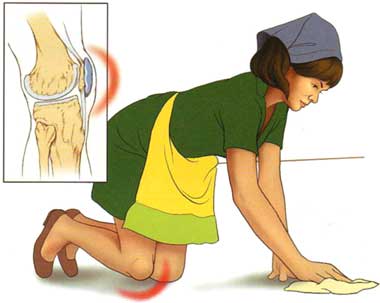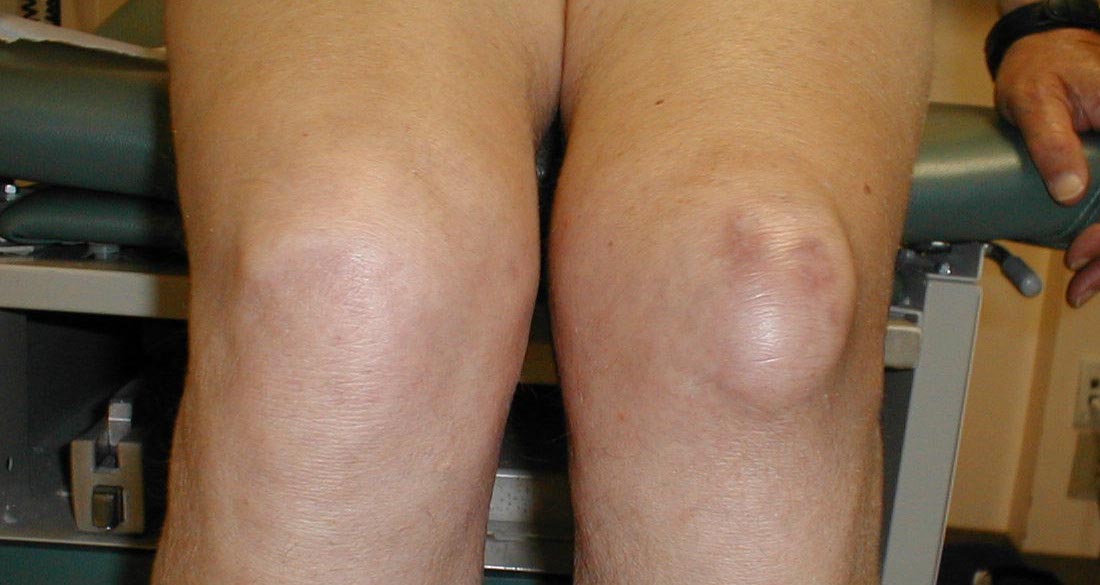 The name, Housemaid’s knee, comes from the historic symptoms housemaids suffered because of scrubbing floors on their knees for a long period, but it can be caused by any activity that requires you to spend too much time bent down onto your knees or squatting for long periods of time.
The name, Housemaid’s knee, comes from the historic symptoms housemaids suffered because of scrubbing floors on their knees for a long period, but it can be caused by any activity that requires you to spend too much time bent down onto your knees or squatting for long periods of time.
What Is Housemaid’s Knee?
 Housemaid’s knee is also known as prepatellar bursitis or knee bursitis because the condition is the result of damage or inflammation to the pre-patellar bursa. The bursa is the sac of fluid that lubricates the joints and prevents friction between the bones in the knee and the soft tissue and skin covering your knee. Pre-patellar refers to the location on the knee; in lay terms it would be known as the kneecap.
Housemaid’s knee is also known as prepatellar bursitis or knee bursitis because the condition is the result of damage or inflammation to the pre-patellar bursa. The bursa is the sac of fluid that lubricates the joints and prevents friction between the bones in the knee and the soft tissue and skin covering your knee. Pre-patellar refers to the location on the knee; in lay terms it would be known as the kneecap.
Symptoms of Housemaid's keen include pain and swelling, which can make it difficult to bend your knee. The stiffness in your knee can affect your ability to walk and kneel normally. You might also notice some redness on the skin over the knee that could feel warm to the touch. If the inflammation is severe, a lump where the fluid is accumulating may form over the knee. A fever might suggest that the condition is a result of infection, and a doctor should be consulted if that happens.
What Causes Housemaid’s Knee?
1. Acute Housemaid’s Knee
Direct blow or fall on the knee. The force can rupture blood vessels, releasing blood. The blood can accumulate around the bursa, causing swelling in the surrounding area and triggering swelling in the bursa. This might cause the walls of the bursa to thicken, causing tenderness even the swelling subsides.
Caused by infections. An injury to the skin on the surface of the knee, such as a cut or scrape, could also be the culprit. If the wound develops an infection, the bacteria can travel to the bursa. The infected bursa will then become inflamed, and swelling will occur.
2. Chronic Housemaid’s Knee
Repeated damage to the knee. This is usually from work that involves extended periods of kneeling. This puts a lot of pressure on the kneecap, and can cause repeated injury to the bursa, causing the walls of the bursa to thicken.
3. Risk Factors
Inflammatory disease. People with inflammatory diseases like rheumatoid arthritis have an increased risk of developing housemaid’s knee.
Gout. Gout causes crystals to form from the uric acid that builds up in the blood stream. These crystals will collect within a joint like your knee.
What Are the Treatment Options for Housemaid’s Knee?
Depending on the severity of the swelling and inflammation in your knee, your doctor may recommend various treatment options.
1. Medication
This will likely be used in cases of infection. Antibiotics will kill the bacteria causing the infection, reducing the swelling in the bursa.
2. Therapy
A physical therapist or a sport’s medicine doctor can work with you to develop an exercise program that will help improve your flexibility and strengthen your muscles. The therapy will focus on stretching the major muscles around your knee to help release the extra fluid from your bursa, helping to diminish your pain and reduce the risk of recurring episodes.
3. Surgery and Other Procedures
- Corticosteroid injections. These injections are common treatments, and can be injected directly into the affected area. This treatment often reduces the inflammation quickly. However, you may have some pain and swelling around the injection site for a day or two.
- Aspiration. During this procedure, the doctor will insert a needle into the bursa and draw the fluid out with a syringe. As with the injection, pain and swelling can occur around the area penetrated by the needle. Your doctor might recommend a knee immobilizer to compress the area around your knee, which will reduce the risk of the swelling recurring.
- Surgery. In severe cases, your doctor could recommend having the bursitis surgically removed. This is only done in the most extreme cases, and only after all less invasive treatments have failed to treat the bursitis.
4. Home Care
- Rest your knee. Avoid activities and movements that cause your pain to be worse.
- Ice your knee. Use icepack on the affected knee. Do this several times a day for 20 minutes at a time. Continue until the pain has subsided, and the skin no longer feels warm totouch.
- Compression. Use a wrap or sleeve that will apply compression to the knee to help reduce swelling.
- Elevate your knee. To reduce swelling, use pillows to prop your knee up at an elevation of four to six inches.
Can Housemaid’s Knee Be Prevented?
As the saying goes, an ounce of prevention is worth a pound of cure. This is especially true with bursitis, as reducing the amount of stress on your knee will improve symptoms.
Kneepads are a wonderful solution for those that must spend extended periods of time kneeling. The pads will cushion your knee, and prevent unnecessary pressure.
Besides, give your knees a break as often as you can. Standing up when you can, walking around when you begin to get stiff or even sitting for a few minutes will all take the pressure off of your knee. If possible, you can even do some stretches while resting to release some of the fluid to prevent it accumulating. Remember, the best way to treat bursitis is not develop inflammation in the bursa in the first place.